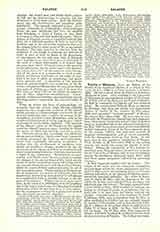

Palafox y Mendoza, JUAN DE, Bishop of La Puebla de los Angeles in Mexico, b. at Fitero in Navarre, June 24, 1600; d. at Osma in Spain, October 1, 1659. He was a son of Jaime de Palafox y Mendoza, Marquess of Ariza. After studying at the University of Salamanca he was appointed member of the Council of War and of the Indies at the Court of Madrid. In 1629 he renounced this dignity and was ordained priest. He accompanied Princess Mary as almoner to Germany and upon his return was consecrated Bishop of Puebla de los Angeles, December 27, 1639, and appointed “visitador general” of Mexico. He arrived there, June, 1640. He soon came in conflict with the Franciscans, Dominicans, and Augustinians, whose many exemptions and privileges he looked upon as encroachments on his episcopal jurisdiction. In May, 1642, he received secret advice from Madrid to take temporary charge of the Government in place of the viceroy, Villena, who had been accused of financial mismanagement and of secret sympathy with the Portuguese rebels in New Spain. At the same time he was appointed Archbishop of Mexico. From June 10 to November 23, 1642, he was acting viceroy, but would not accept the dignity of archbishop. During his viceroyalty of five months he corrected many financial abuses, framed new statutes for the University of Mexico, and, to root out idolatry among the aborigines, destroyed many Aztec idols and other pagan antiquities collected by preceding viceroys. In 1647 began his conflict with the Jesuits. The reason of the strife was the numerous exemptions and privileges which the Jesuit missionaries had enjoyed in Mexico since the beginning of the seventeenth century and which, in the opinion of Palafox, undermined his episcopal authority. In a letter to Innocent X, dated May 25, 1647, he denounced the use which the Jesuits were making of their privileges and asked the pope for redress. The pope answered with a brief, dated May 14, 1648, in which he sustains the bishop in all disputed points of jurisdiction, but exhorts him to be more kind and lenient towards the Jesuits. A second letter to Pope Innocent X, dated January 8, 1649, more acrimonious than the first, is often attributed to Palafox, but was probably forged by enemies of the Jesuits, as it is disavowed by Palafox in a defense of his actions which he addressed to Philip IV of Spain in 1652. In May, 1649, Palafox left for Spain. On May 27, 1653, Pope Innocent X issued a new brief, in which he confirmed his previous decision in favor of Palafox. The bishop was transferred to the Diocese of Osma in Spain on November 24, 1653. He spent the remainder of his life laboring with his usual zeal for the spiritual welfare of his flock, which honored and reverenced him as a saint. The process of his canonization was introduced in 1726 under Benedict XIII and was continued during the pontificates of Benedict XIV, Clement XIII, Clement XIV, and Pius VI. At the last session which was held on February 28, 1777, twenty-six out of forty-one votes favored his beatification, but Pius VI suspended the final decision. His literary productions, consisting chiefly of ascetical, pastoral, and historical treatises in Spanish, were published in fifteen volumes (Madrid, 1762).
MICHAEL OTT

